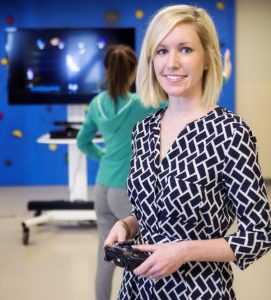
Photo by Collin Richie
Dr. Amanda Staiano’s surprising prescription for fighting adolescent obesity? Video games.
Staiano completed a study, aptly named Klub Kinect, where teen girls played Xbox Kinect dance “exergames” as a way to get fit.
Exergames are active video games that require full body movement, such as Just Dance and Dance Central. While they played, Staiano monitored the participants from behind two-way mirrors.
While the official report will be published later this year, the preliminary results were encouraging: Almost all participants completed the trial, and many were in much better shape when they left than when they started.
It’s no coincidence that Klub Kinect features dance games. “Girls are more likely to be interested in dance than sports,” Staiano says.
Staiano used to be a dancer herself. Coming out of college, she initially planned to tackle health issues many dancers struggle with, like anorexia or bulimia.
“But after I got to Pennington, I felt the health issue of the 21st century was obesity. So, when the opportunity [to study it] presented itself, I jumped on it,” she says.
Staiano’s Klub Kinect study involved 42 girls ages 14-18 with a body mass index percentile (BMI) of 85 or higher. Participants were randomly assigned to either a 12-week exergaming intervention, in which they attended 60-minute group exergaming sessions three times per week, or a control group, in which participants were instructed to continue their previous level of activity for 12 weeks. At the end of the study, body weight, BMI, blood pressure, lifestyle and psychosocial behaviors were measured, along with enjoyment of the intervention and various other factors.
A huge part of what made the study so successful was the non-threatening environment Staiano created: a workout room painted in bright colors complete with assorted fitness equipment such as exercise bikes. To make the study feel more like fun than exercise, the fitness instructors on hand to guide the participants were called “gaming coaches.”
It was also important that Klub Kinect participants were gaming with peers in a similar physical shape.
“Here, their eyes were on the screen, not on each other. They’re not thinking about how they look,” Staiano says.
She met some resistance to her study from people who wondered whether playing a video game was really exercise. “It’s an uphill battle,” she says. “It was hard to convince grant reviewers that this is legitimate. But fortunately there has been a lot of data coming out recently that proves that gaming can reach moderate fitness levels.”
Now the dancer-turned-doctor is motivating future generations to dance away the pounds-giving teens a fun prescription of dance exergames to reach their goals..
Read More![]() 225 Magazine
225 Magazine
Research Details
- Research Center: Pennington Biomedical Research Center
- Featured NORC Member(s): Amanda Staiano, PhD, Assistant Professor of Pediatric Obesity and Health Behavior

